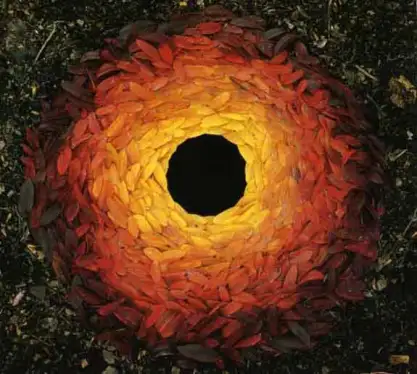Spying lens
Describe and analyze
At the foreground, Hartini represented herself in the work as a female figure curling up in a fetal like position. The figure is naked, except for a blue-flowing cloth wrapped around her naked body. The cloth extends from the foreground to the background and connects the figure to the rest of the picture. Around the figure is a harsh landscape made up of lines of cracked brick walls and rough stone walls which slowly disappears into the sky at the background, creating a sense of depth to the painting. Hence, the foreground, middle ground and back ground are connected by the cloth and the walls.
Hartini has carefully outlined most of the objects in the painting. For example, the obvious cracks of the walls are drawn using black shadows and lines and the brick walls are brought out by the white lines. The contrast in colour brings our attention to the wall, since the wall itself is a form of line; it also guides our eye movement from the foreground of the painting to the background.
The female figure at the foreground has been simplified yet we can still recognize it easily. However, the proportion between the human figure and the walls is very unbalanced. The size of the figure is too big as compare to the size of the wall.
Also, there is a clear sense of space in this painting. The bright orange colour from the brick wall at the foreground has created the positive space while the black colour sky at the background has created the negative space.
Overall, the subject matter in the painting all has a well finished look. The brushstroke is extremely fine and the colours used are quite close to real life, even the cracks on the walls are carefully painted. Also, Hartini like to use complementary colours. For example, the blue- flowing cloth and the red brick wall. The use of complementary colours creates tension in the painting as the colours clash and cause discomfort when placed together. We can tell from the painting that Hartini has been influenced by surrealism. She placed these unrelated elements together and successfully created a dreamlike quality and an unrealistic feeling in the painting.
Symbolism
The use of brick walls surrounding the human figure brings out the idea of being trapped and corned. This can relate to the artist’s history as a domestic violence victim. The presence of the eyes floating in the air is the symbol of always being watched. The eyes surrounding the female figure and casting light beams on her naked body, thus represents the society’s eye on Hartini’s personal life. The blue- wrapped cloth has an idea of a safety net to hold and support the female figure. Hence the female figure is able to float in the mid air and unharmed by the harsh environment.
Frida Kahlo
“I was born a bitch. I was born a painter.” – Frida Kahlo
“I paint myself because I am so often alone and because I am the subject I know best.” – Frida Kahlo
Self-portrait with Thorn Necklace and Hummingbird
Compare and contrast Frida Kahlo and Lucia Hartini
These two paintings are quite similar in the way that both artists are trying to express their personal life through their art works. The use of symbolism is especially clear in both paintings. In spying lens, subjects like the blue- wrapped cloth, the brick walls and the eyes surrounding the female figure all have meanings behind them. In Kahlo’s self portrait, the monkey resting on her right shoulder may represent one of her pet monkey. Since Kahlo was unable to give birth, the act of the money trying to free her from the thorns may symbolize Kahlo’s life with her pet monkeys. The monkeys might have given her some comfort even though she was unable to give birth. Also, the black cat resting on her left shoulder may symbolize the misfortune in her life as black cat carries the meaning of bad luck while the insects on her head may suggest flight and freedom.
The painting style of the two artists is also very similar. They like to paint their subject matter in a realistic way, the brushstrokes are almost invisible and the colours used are relatively realistic. However, both of them are not interested in painting a purely realistic scene; instead, they arrange the symbolic elements to communicate their feeling and idea through the paintings.















